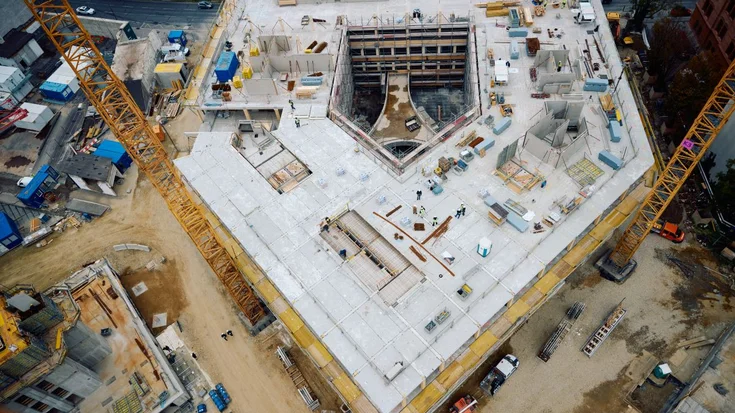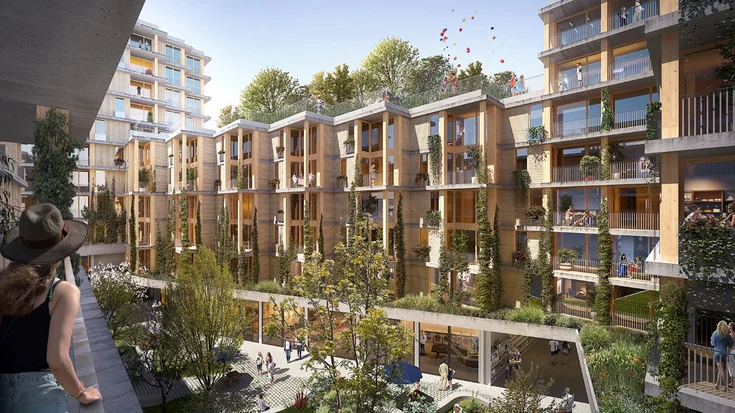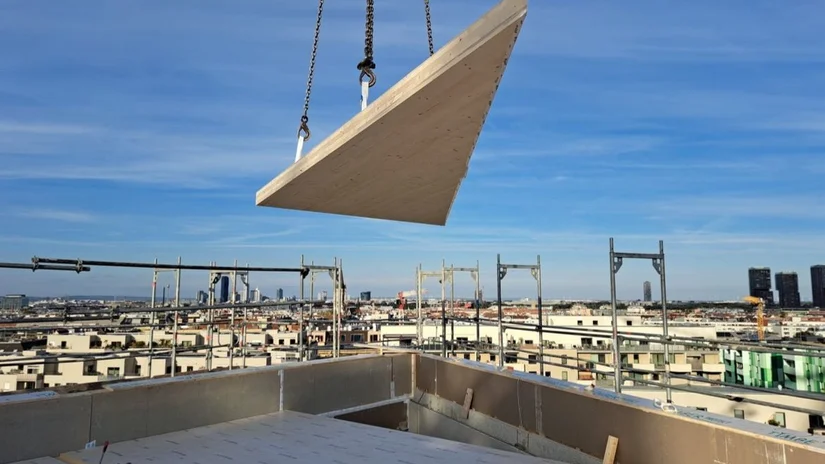5 answers on the topic of timber construction

TAINA
BILITY
Harald Hobacher, head of the timber engineering department, explains why wood is so effective in hybrid structures, and how it makes projects particularly Green and Lean.
1. Why are we building more with wood?
Sustainable construction is becoming increasingly important. The choice of the right building materials plays a decisive role in this. This is because they influence the entire life cycle of a building. Wood is a local, renewable and recyclable material. This makes it the ideal building material, which we use efficiently but also pragmatically for Building construction projects. More and more projects are being realised using hybrid construction methods, where wood offers many possibilities. The same applies to increased requirements in the areas of sound insulation and fire protection. It is therefore not surprising that ecologically sustainable solutions are being sought in public tenders and competitions. This is because public building owners have a role model function. The choice of building material also influences the construction schedule. Timber components can be manufactured as large-format building elements - detached from the construction site - and precisely assembled on site. This guarantees rapid construction progress.
2. What are the benefits of the building material?

Wood is very versatile. From a technical point of view, it is a natural top product in terms of its own weight to load-bearing capacity compared to conventional materials. It is easy to obtain, available almost anywhere in the world and brings a sustainable, environmentally friendly aspect to future construction. It is used as a load-bearing structure for buildings, as an insulating material due to its good insulating properties and as sustainable façade cladding. In the required dimensions in which we realise multi-storey, large-volume construction projects, a timber hybrid construction method in combination with steel and concrete is always the most effective. It combines all the positive properties of the building materials. A good example is the already completed Florido Liner, where the load-bearing structure consists of wood-concrete composite ceilings, prefabricated reinforced concrete columns, a solid reinforced concrete core, steel hybrid beams and cross-laminated timber exterior walls. A sophisticated building in which PORR has impressively demonstrated: We use every building material. Wood is also absolutely competitive. The cost-relevant deficits of timber construction here in Austria compared to conventional, albeit qualitatively difficult to compare solid construction, can be relativised in the future through greater scaling, optimisation of the building material and standardisation, but also through socio-economic incentives
3. what would you like to build out of wood?

Since my training as a civil engineer, I have been able to realise building construction projects using a wide variety of building materials. But my heart still beats for structural engineering. That's why I would like to plan and build long-span bridges made of timber or timber hybrid structures. Timber components offer very good properties in terms of fatigue behaviour, which are already being used in bridges, crane runways or wind turbine towers. If the technical potential of wood is further researched and utilised in the future, as well as the rules of timber construction such as structural timber protection are observed, there are hardly any limits.
4. how does timber construction fit in with PORR's Green and Lean strategy?
I would say it fits like a glove. In addition to the sustainable aspects, timber construction is predestined for the Lean philosophy. It conserves resources and relies heavily on prefabrication in its industrial processes. The process must be planned and considered in advance.
5. which timber construction projects is PORR currently realising?
I would like to mention three projects: Firstly, in the new urban development area Village im Dritten, we are realising one of the largest and tallest timber buildings in Austria with the Vis-à-Vis project together with our colleagues from the Vienna Building Construction Department.
Our timber projects

The eight above-ground storeys in a timber hybrid structure comprise 113 flats, five shops and a kindergarten. We from the pde carried out structural optimisations, supported the planning phase and took care of the timber construction management on site. Working shoulder to shoulder with the client Schwarzatal and the specialist planners involved, we redesigned the project in such a way that the respective material properties of timber and reinforced concrete were optimally utilised. The solid wood ceilings used have a visible wooden surface. The exterior walls are delivered from Carinthia in prefabricated elements up to 12 metres long with a finished timber façade for assembly.
Secondly, on Vienna's Danube Canal and in Europe's first timber hybrid urban quarter, PORR is also building one of Europe's largest timber construction projects as general contractor. The ten-storey LeopoldQuartier OFFICE office building and the 253 flats in the LeopoldQuartier LIVING will use a total of 6,600 m3 of timber, thereby binding 6,600 tonnes of CO2 in the long term. This includes 20,000 m2 of wood-concrete composite ceilings, 700 glulam columns, 20,000 m2 of cross-laminated timber elements and 7,000 m2 of timber frame exterior walls.
And thirdly, in Vienna-Favoriten, we are realising the fully hybrid housing project B.R.I.O. as part of the Neues Landgut urban development area. Together with our colleagues from the Vienna Building Construction Department, we are building the project using a newly developed serial construction method consisting of prefabricated elements, solid timber components and prefabricated timber frame walls. The high degree of prefabricated timber and concrete components, as well as the combination of these, enables an optimised construction process. Compared to conventional reinforced concrete construction, this saves around 20 % CO2.





